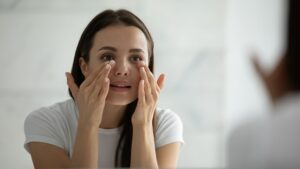When Should I Be Concerned About Dry Eyes?
 Dry Eye is a common condition that affects many individuals. It is typically characterized by stinging, burning, and/or scratchy sensations in the eyes. While often merely an annoyance, there are situations when dry eyes warrant more serious attention. Dry Eye Syndrome can occur when tears cannot provide enough moisture. This can be due to either decreased tear production or increased tear evaporation. Factors like meibomian gland blockage, blepharitis, aqueous deficiency, and environmental conditions can all contribute to this condition.
Dry Eye is a common condition that affects many individuals. It is typically characterized by stinging, burning, and/or scratchy sensations in the eyes. While often merely an annoyance, there are situations when dry eyes warrant more serious attention. Dry Eye Syndrome can occur when tears cannot provide enough moisture. This can be due to either decreased tear production or increased tear evaporation. Factors like meibomian gland blockage, blepharitis, aqueous deficiency, and environmental conditions can all contribute to this condition.
The usual symptoms of Dry Eye Syndrome may include a sandy or gritty feeling in the eyes, sensitivity to light, redness, and blurred vision. When these symptoms persist or worsen, they can disrupt daily activities and significantly affect your quality of life. You should become concerned and seek medical treatment if you are experiencing:
- Persistent Discomfort: If the sensation of dry eyes continues despite over-the-counter remedies such as artificial tears or adjustments to daily habits and your environment (e.g. reducing screen time, using a humidifier), it’s time to consult an eye care professional.
- Increasing Redness or Inflammation: Redness and swelling can sometimes indicate an underlying condition that may require medical treatment.
- Vision Changes: If you experience persistent blurred vision or visual disturbances, this could suggest severe Dry Eye Syndrome or another eye condition that needs immediate attention.
- Pain or Sensitivity to Light: These symptoms, particularly when severe, suggest that the dry eyes may have led to further complications, such as an infection or corneal damage.
- Lack of Relief from Non-Medicated Treatments: If non-medicated eye drops and other options do not provide adequate symptom relief, that may mean that a medicated approach is necessary.
At Prestera Eye Medical Group, our eye doctors, Dr. Tory Prestera and Dr. Howard Guan, offer a couple of different treatment options for patients struggling with Dry Eye Syndrome and symptoms that won’t let up. Medicated eye drops are a common solution that help relieve sensitivity and restore lubrication. Both eyelid and corneal inflammation can be addressed with medicated eye drops, as well as natural tear production. Another option is a punctal plug procedure. Punctal plugs are tiny, gentle devices inserted into the tear ducts that can prevent the natural draining of liquid, thus helping to retain water and alleviate dryness. There are both temporary and semi-permanent punctal plug options available.
To learn more about Dry Eye Syndrome and treatment, or to schedule a consultation with Dr. Prestera or Dr. Guan, please contact our office today.